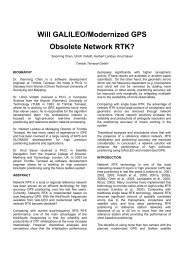GPS Integrity and Potential Impact on Aviation Safety - intelligent ...
GPS Integrity and Potential Impact on Aviation Safety - intelligent ...
GPS Integrity and Potential Impact on Aviation Safety - intelligent ...
Create successful ePaper yourself
Turn your PDF publications into a flip-book with our unique Google optimized e-Paper software.
NO. 1 <str<strong>on</strong>g>GPS</str<strong>on</strong>g> AND AVIATION SAFETY 53<br />
2.1. Accuracy. Accuracy is defined as the degree of c<strong>on</strong>formance of an estimated<br />
or measured positi<strong>on</strong> at a given time to a defined reference value. Ideally, this reference<br />
value should be a true value, if known, or some agreed-up<strong>on</strong> st<str<strong>on</strong>g>and</str<strong>on</strong>g>ard value. Accuracy<br />
should not be c<strong>on</strong>fused with precisi<strong>on</strong>, which denotes a measurement quality that<br />
describes how well repeated measurements agree with themselves rather than with a<br />
reference value. The accuracy requirement of a GNSS navigati<strong>on</strong> system is specified at<br />
the 95th percentile, i.e. for any estimated positi<strong>on</strong> at a specific locati<strong>on</strong>, the probability<br />
that the positi<strong>on</strong> error is within the accuracy requirement should be at least 95%.<br />
2.2. C<strong>on</strong>tinuity. C<strong>on</strong>tinuity of a navigati<strong>on</strong> system is its capability to perform its<br />
functi<strong>on</strong> without n<strong>on</strong>-scheduled interrupti<strong>on</strong>s during the intended period of operati<strong>on</strong><br />
(POP). It relates to the capability of the navigati<strong>on</strong> system to provide a navigati<strong>on</strong><br />
output with the specified level of accuracy <str<strong>on</strong>g>and</str<strong>on</strong>g> integrity throughout the intended POP,<br />
assuming that it was available at the start of the operati<strong>on</strong>. The POP depends <strong>on</strong> the<br />
phase of flight, for example, 1 hour for en-route. C<strong>on</strong>tinuity risk is the probability that<br />
the system will be interrupted <str<strong>on</strong>g>and</str<strong>on</strong>g> not provide guidance informati<strong>on</strong> for the intended<br />
POP. The risk is a measure of system unreliability.<br />
2.3. Availability. Availability is defined as the percentage of time during which<br />
the service is available (i.e. reliable informati<strong>on</strong> is presented to the crew, autopilot or<br />
other system managing the flight of the aircraft) for use taking into account all the<br />
outages whatever their origins. The service is available if accuracy, integrity <str<strong>on</strong>g>and</str<strong>on</strong>g> c<strong>on</strong>tinuity<br />
requirements are satisfied. Unlike ground navigati<strong>on</strong>al aid infrastructures, the<br />
availability of GNSS is complicated by the movement of satellites relative to a coverage<br />
area <str<strong>on</strong>g>and</str<strong>on</strong>g> the potentially l<strong>on</strong>g time to restore a satellite in the event of a failure.<br />
Accurately measuring the availability of such a system would take many years, to allow<br />
the measurement period to be l<strong>on</strong>ger than the mean time before failure <str<strong>on</strong>g>and</str<strong>on</strong>g> to repair<br />
(MTBF <str<strong>on</strong>g>and</str<strong>on</strong>g> MTTR). Hence the availability of GNSS is determined through design,<br />
analysis <str<strong>on</strong>g>and</str<strong>on</strong>g> modelling, rather than measurement. True system availability can <strong>on</strong>ly be<br />
determined (by measurement) after the end of its life.<br />
2.4. <str<strong>on</strong>g>Integrity</str<strong>on</strong>g>. <str<strong>on</strong>g>Integrity</str<strong>on</strong>g> relates to the level of trust that can be placed in the<br />
informati<strong>on</strong> provided by the navigati<strong>on</strong> system. It includes the ability of the navigati<strong>on</strong><br />
system to provide timely <str<strong>on</strong>g>and</str<strong>on</strong>g> valid warnings to users when the system must not be used<br />
for theintended operati<strong>on</strong> or phaseof flight. Specifically, anavigati<strong>on</strong> system isrequired<br />
to deliver a warning (an alert) of any malfuncti<strong>on</strong> (as a result of a set alert limit being<br />
exceeded) to users within a given period of time (time-to-alert). <str<strong>on</strong>g>Integrity</str<strong>on</strong>g> risk, also<br />
referred to as the probability of misleading informati<strong>on</strong>, is defined as the probability<br />
that the navigati<strong>on</strong> positi<strong>on</strong>ing error exceeds the alert limit <str<strong>on</strong>g>and</str<strong>on</strong>g> that the event is not<br />
detected.<br />
Loss of integrity can happen in <strong>on</strong>e of two ways. Either an unsafe c<strong>on</strong>diti<strong>on</strong> is not<br />
detected or it is detected, but the alert is not received by the user within the time-to-alert.<br />
The alert limit defines the largest positi<strong>on</strong> error, which results in a safe operati<strong>on</strong>. This<br />
is specified such that the error can degrade to a level larger than the 95th percentile<br />
accuracy requirement but still within a safe limit. Time-to-alert is defined as the maximum<br />
time allowed from the moment a fault resulting in an unsafe c<strong>on</strong>diti<strong>on</strong> is detected<br />
to the moment that the user is made aware of it.<br />
Traditi<strong>on</strong>ally, some comp<strong>on</strong>ent of the navigati<strong>on</strong> system <str<strong>on</strong>g>and</str<strong>on</strong>g>/or an independent<br />
m<strong>on</strong>itoring unit assures integrity by m<strong>on</strong>itoring the transmitted signals <str<strong>on</strong>g>and</str<strong>on</strong>g> provides<br />
a timely warning when they are out of specificati<strong>on</strong>. For example, LORAN-C provides<br />
system integrity by m<strong>on</strong>itoring timing accuracy. Stati<strong>on</strong>s that exceed the system



